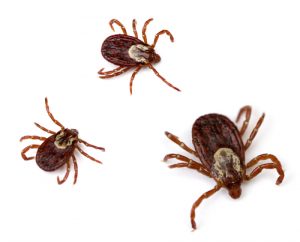Ticks Suck in more way’s than one!
By Chris Williams on January 11, 2012.
I’m a fan of most arachnids such as spiders, scorpions, and harvestmen. Why you ask? Because they mostly hunt for a living, use venom, have fangs, etc. You know, creepy, cool stuff like that!! I could go on and on, but there is one group of arachnids I have absolutely no use for and that would be the ticks.
Now, I’ve always liked taxonomy (identification and classification of species based on physical characteristics) as a concept, but taxonomists drive me crazy because they’re always upgrading (or downgrading) the organisms they specialize in. It’s a wonder the poor things don’t have an identity crisis! When I was in school, mites and ticks were always classed as arachnids based upon common characteristics like four pairs of legs, a pair of specialized mouthparts called chelicerae, and a pair of appendages for manipulating food called pedipalps. They were once assigned to the order Acari and divided into hundreds of families. Now the entire group (because it’s so huge) has been upgraded to its very own class! (http://www.australasian-arachnology.org/arachnology/acari/)
Mites are a hugely diverse group in terms of lifestyle and habitat. Many species are beneficial predators (on other mites) however; many are parasitic and serious pests of plant and animal health. The largest mites (aka) ticks are all blood-feeders on terrestrial cold and warm-blooded vertebrate hosts. With over 800 species worldwide, ticks have veterinary and medical significance due to their feeding habits including, blood loss, possible allergic reactions, often unusual toxic reactions (paralysis) in the host, and most importantly the transmission of pathogenic organisms. Like I said before, I have no use for them and they actually even creep ME out!
 There are two families (Ixodidae and Argasidae) of medically important ticks. The much smaller family of ‘soft’ ticks (family Argasidae) have not been recorded as existing in the northeast, so all the common species here are the ‘hard’ ticks. (Ixodidae) The two most commonly encountered species (in NH anyway) are the American Dog Tick (Dermacentor variabilis) and the black-legged tick, (Ixodes scapularis). (A.Eaton, 2009)
There are two families (Ixodidae and Argasidae) of medically important ticks. The much smaller family of ‘soft’ ticks (family Argasidae) have not been recorded as existing in the northeast, so all the common species here are the ‘hard’ ticks. (Ixodidae) The two most commonly encountered species (in NH anyway) are the American Dog Tick (Dermacentor variabilis) and the black-legged tick, (Ixodes scapularis). (A.Eaton, 2009)
Why I hate ticks the most is because they are very efficient at carrying and transmitting disease causing organisms to their hosts. (T. Sanson, MD) Bacteria, viruses, rickettsia, and spirochetes are just a few of the pathogens transmitted by tick bites causing many different diseases. (Lyme, RMS, Anaplasmosis, Babesiosis etc.)
All of these diseases can be transmitted by the two most common species we have here in New England. I’m personally not too worried about possibly contracting Rocky Mountain spotted fever from American dog tick, but toxic reactions to the tick’s bite are definitely a concern because of an incident that happened to my mother in law about twenty years ago. She once had a very sudden onset of severe headache and vertigo. (She’d never had been a migraine sufferer.) Emergency room physicians could find nothing wrong with her, but later she discovered an embedded tick and after removing it, the symptoms quickly went away. Now that could have been entirely coincidental, but I bet something was going on there. The other thing I’m worried about is that for the first time ever this past fall, white-tailed deer were feeding in my orchard. I’ve identified juvenile black-legged (Lyme disease) ticks that my neighbor across the street has pulled off her pets and deer regularly visit her yard which borders woodland. Should I take comfort that only between 20 to 50 percent of the deer ticks in NH were found to be Infected with Borrelia burgdorferi in a recently conducted study?(A. Eaton 2009) I don’t think so. I’m going to be vigilant when I’m working in my orchard. If you have deer frequent your property, you should be too.
The following links are excellent resources for more information on tick biology and tick-borne diseases.
PDF]
Biology and Management of Ticks in New Hampshire
www.wildnh.com/…/Ticks_Biology_&_Mgt_in_NH_CoopExt_May0…
File Format: PDF/Adobe Acrobat – Quick View
http://emedicine.medscape.com/article/786652-overview